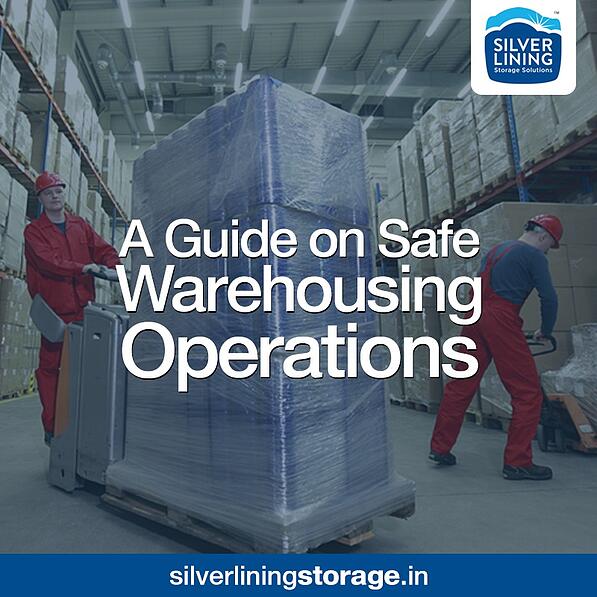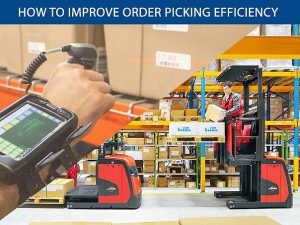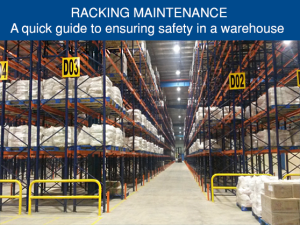In warehousing operations, the importance given to human safety is paramount. The health and safety of employees is a priority that the sector shares along the same value lines as customer satisfaction. This means that warehouse management has to take up an affirmative action plan to control safety risks, and educate workers about such through written and instructional basis. To establish safety during all sorts of warehousing operations, here are a few guidelines you shouldn’t miss to follow.
> Keep all potential safety hazards away
Storage racks are the backbone of the warehousing/distribution center. Their maintenance and safety should be a regular part of logistics operations. It is important to run a safety check every day in places including the warehouse racking by all the employees. Things such as stray cords, wiring, or any flammable liquid around the stored items can be dangerous. Also, things like cracked floors or weak storage facilities like dislocated warehouse racking/shelving is also risky if not paid attention to. Warehousing storage racks are the common places where mishaps take place. The reasons are congestion due to loose material at aisles, disordered workplaces and improper cleaning.
Pallet racking provides an optimal and easy way to store and retrieve material in a warehouse. They are used in vast applications such as distribution centres, manufacturing facilities, commercial and wholesale operations. Whether you have Selective, Drive-in pallet racking, or other types of storage racks, the concerns are often similar.
It is imperative to have the understanding of how to properly use the racking, otherwise, it’ll pose an expensive risk. Here are few common mistakes people make which may result in racking collapse, serious injuries, fatalities and stock damage.
– Making changes to racking components and configuration
Storage racking for palletized goods are designed specifically for the size, pallet type and weight of the products being stored. The operational capabilities will change as a result of any modifications to the racking structure. Hence, it is unsafe to alter the racking and pallet specifications without consulting your pallet racking supplier. It is also not advisable to dismantle and move the pallet racking by individuals without the necessary level of experience.
– Overloading in a racking system
As every warehouse racking comes with a loading capacity, it is essential that all operators are aware of the system capabilities to not to overload or exceed the safe working unit load limit or total load per bay for a pallet racking system. If not followed, it could cause a racking collapse and result in a major accident and fatalities. To make sure this doesn’t happen, even if you do not cross the loading capacity, it’s recommended to store the heaviest goods at the bottom levels and the less heavier/ lighter ones on the middle and top racking levels. There should also be one or more signs at the end of all aisles, which contain the following information:
- Safe working unit load
- Max bay load
- Height at different loading levels
- Max load in uniform distribution (for shelving)
- Pallet Racking supplier contact details
– Climbing on racking for pick-up
The wire decks/plain shelves on the storage racks are only designed to hold a certain amount of uniformly distributed weight . They aren’t designed to be stood on or climbed on. Many times, workers may prefer climbing on the racks components/shelves to load or unload material, instead of using an equipment or a proper ladder to get to the required height. This is what may damage the shelve/deck and also result in a mishap involving the worker(s). The surface of these shelves is flexible and subjected to lateral motion which may result in material falling off the shelves and serious injury for workers. The necessary training and guidelines should be put in place to ward off this practice.
– Working at heights
Fall protection is necessary when employees work at various warehousing levels or at a height, especially in storage systems like Multi-tier Shelving or Mezzanine. It’s vital to have fall restraint/ arrest system such as guardrails, back/side mesh, kick plates, warning lines, safety harness etc. to prevent persons or objects to fall.
Basic guidelines for proper use of pallet racking system
- Educate all warehouse personnel to report racking, equipment or any damage to the competent authority as and when happens or when they first spot it.
- Conduct regular visual inspections by supervisors for the storage racks damages and maintenance
- Educate operators on correct positioning of pallets on to the racking systems
- Appropriate usage of warehouse material handling equipment with respect to height, load and size
- Make sure pallets don’t protrude beyond the specified limits
- Regular inspection of pallets condition for broken or fractured deck boards, chamfer, stringers and protruding nails.
- Use of safety accessories such as column guards or frame protectors to reduce potential damage to racking from warehouse equipment.
For maintaining a safe working environment, it is vital that the formal racking inspection is carried out by a qualified inspector on a regular basis to ensure the racking system is used safely and also to increase its life time.
Any damage to any racking component will reduce the total system load bearing capacity. It should be reported to the racking supplier and need to be replaced ASAP.
> Warehouse Material Handling Equipment (Forklifts)
Keeping the safety of users in mind, it is our belief that any equipment in use needs proper training, inspection and operational methodology. Forklift turnovers are the most cited reasons for mishaps and injuries in warehousing.
It is recommended to follow below guidelines for safe operations.
- Ensure that only the trained or certified operators use warehouse trucks
- Before using a forklift, examine it for pristine conditions
- Carry out periodic maintenance and withdraw defective trucks from operations until the necessary repair is done
- Follow safe procedures for picking up, stacking and retrieving the loads from racking
- Do not handle loads that are heavier than the weight capacity of the forklift
- Drive safely, never exceeding 5 mph and slowdown in congested areas
- Prohibit stunt driving and horseplay
- Maintain safe clearances for aisles or passages and docks where forklifts are used
> Manual handling & ergonomics:
It is quite common that improper handling of material may cost physical injuries or overexertion. To end this, it is required that workers are properly trained in general material handling techniques as well as task specific training. The aim is to use techniques of design and engineering to minimize the need for physical exertion.
Another common issue is that of repetitive motion, which can cause injuries in the long run. To make sure that this is not a common feature of warehousing, make sure workers use ergonomic techniques as much as possible. Here are some pointers:
- Reduce lifting from shoulder height & from floor height
- Keep your back in natural position while lifting
- Depending on the weight and size of the package, employ appropriate lifting techniques
- Ask a co-worker to help out in case it is necessary
- Shift feet and take small steps instead of shifting load on its entirety.
> Docks safety
Docks are a significant feature of warehouses where goods are loaded and unloaded. However, there is always a danger of running off the docks while using forklifts or equipment striking a person. Here are some essential tops to ensure worker safety:
- Drive slowly and carefully, making sure that no one is in in the path of forklifts, forwards or backwards.
- Keep clear of edges by always keeping in mind visual warnings drawn on the ground.
- Make sure ladders and stairs are placed appropriately with visual directions in place.
- Make sure that dock plates are in place and that the weight of the machine & equipment is lesser than the prescribed weight limit of dock plates.
- Exposed or open loading dock doors and other areas should be chained/roped off, or otherwise blocked.
> Always have response plans for emergencies
Improper or inadequate safety measures can be more dangerous than the hazards themselves. Therefore, it is important to have the workers and other staff trained to take the correct action in times of emergencies. Information like emergency phone numbers, where the fire extinguishers and first aid kits are situated, etc. is more important than it may seem to be.
> Have a trained staff
Without proper training and education, the warehouse employees may not perform as good as they can. Many warehouses tend to skip the training process at times to save money and time but it can prove to be hazardous to the employees as well as the organization as a whole. The number one cause for injury at warehouse workplaces is an untrained staff. Thus, proper and regular safety training should not be underestimated. Moreover, experts recommend conducting training audits for the staff to ensure that safety regulations and guidelines are being followed at all times.
> Ensure use of safety equipment and signs at the workplace
As stated above, to minimize the risks of workplace injuries, safety equipment should be worn at all times. It could be a little time consuming considering the kind of safety gear the employees need to use but is will always pay off in the long run. Also, signboards that imply dangerous zones at a workplace can be put in the surroundings such as on the edge of warehouse racking. There should be safety convex mirrors fixed appropriately on the racking in all aisle intersections for increased visibility for forklift operators.
> Pay attention to flooring and lighting
Even if the floor isn’t wet, it could be slippery depending on the kind of footwear a worker may use. To avoid slipping, make sure the floors are covered in a layer of thin carpet or vinyl. This will make it slip-proof at all times and also minimize the cleaning process. The lighting in a warehouse should not be excessively bright to avoid blinding the workers at an angle. It also shouldn’t be too dim as this will lead to more mishaps if it gets dark. Since warehouses seldom have proper ventilation or huge windows to let the light in, generators should be installed and maintained so there is no difficulty in working and the work does not come to a halt due to such a minor and external reason.
Develop a culture of safety for efficient warehousing operations
Safety standards of the highest order get reflected in working culture of the warehouse and are passed onto the customer. Needless damage does not bode well for any player involved. Clearly defined safety guidelines mean better safety for employees and higher productivity for the business. Thus, companies can concentrate on improving their supply chain management and increase productivity.
Speak to storage solutions experts at SILVER LINING to get recommendations on how to (re)organize and optimize your warehouse storage and handling operations. Drop us a mail to schedule a quick chat.




